
The Marchantiophyta are a division of non-vascular land plants commonly referred to as hepatics or liverworts. Like mosses and hornworts, they have a gametophyte-dominant life cycle, in which cells of the plant carry only a single set of genetic information.
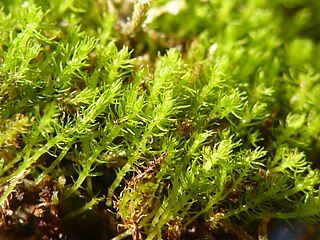
Takakia is a genus of two species of mosses known from western North America and central and eastern Asia. The genus is placed as a separate family, order and class among the mosses. It has had a history of uncertain placement, but the discovery of sporophytes clearly of the moss-type firmly supports placement with the mosses.

The Funariidae are a widespread group of mosses in class Bryopsida. The majority of species belong to the genera Funaria and Physcomitrium.

Tetraphidaceae is a family of mosses. It includes only the two genera Tetraphis and Tetrodontium, each with two species. The defining feature of the family is the 4-toothed peristome.

Radula is a genus of liverwort in the family Radulaceae. The genus includes over 236 species of small plants that typically grow as green, scaly patches on tree trunks, logs, or rocks in moist environments. It is distinguished from other liverworts by several unique features, including the production of root-like structures (rhizoids) exclusively from leaf surfaces and characteristic branching patterns. The plants have rounded, overlapping leaves consisting of two unequal lobes, with considerable variation in structure across species. Following a major taxonomic revision in 2022, the genus comprises five subgenera with distributions ranging from tropical to temperate regions. The oldest known fossil species, R. cretacea, found in Burmese amber, dates to the Cenomanian age, though molecular evidence suggests the genus originated in the Triassic period, around 228 million years ago.
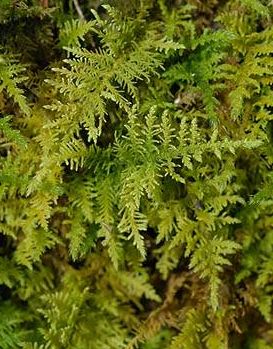
Hypnales is the botanical name of an order of Bryophyta or leafy mosses. This group is sometimes called feather mosses, referring to their freely branched stems. The order includes more than 40 families and more than 4,000 species, making them the largest order of mosses.

Ptilidium is a genus of liverwort, and is the only genus in family Ptilidiaceae. It includes only three species: Ptilidium californicum, Ptilidium ciliare, and Ptilidium pulcherrimum. The genus is distributed throughout the arctic and subarctic, with disjunct populations in New Zealand and Tierra del Fuego. Molecular analysis suggests that the genus has few close relatives and diverged from other leafy liverworts early in their evolution.

Leucobryaceae is a family of haplolepideous mosses (Dicranidae) in the order Dicranales.

Itatiella ulei is a species of moss in the family Polytrichaceae. It is the only species in the genus Itatiella. The Polytrichaceae is a common family of mosses that does not have close living relatives. Its small size and the inflexed leaf apex characterize Itatiella ulei. When this species grows directly exposed to sun at high elevations, it presents a similar aspect but can be distinguished based on the distal lamella cells which are single and rhombic.

Splachnaceae is a family of mosses, containing around 70 species in 6 genera. Around half of those species are entomophilous, using insects to disperse their spores, a characteristic found in no other seedless land plants.
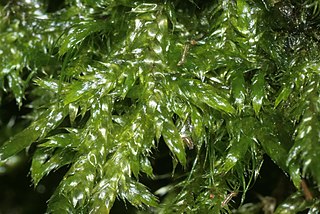
Sematophyllaceae is a family of mosses, known commonly as signal mosses. They grow on rocks in wet or humid places. and are found nearly worldwide, especially in tropical and temperate regions. There are about 150 species, which form yellow to yellow-green mats with reddish stems.

Bartramia is a genus of mosses in the family Bartramiaceae. The genus was first formally described by Johann Hedwig in 1801. There are about 72 species, usually growing on soil, sometimes on rocks, in many habitats in many parts of the world, although tropical species are only found at high altitudes. Nine species occur in Australia but only three of these are endemic to that continent.
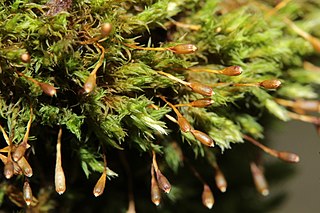
Ulota is a genus of mosses comprising 69 species with a worldwide distribution, though most species are found in the southern hemisphere.

Distichium is a genus of haplolepideous mosses (Dicranidae) in the monotypic family Distichiaceae.
Timmiellaceae is a family of haplolepideous mosses (Dicranidae). It contains two genera, Luisierella and Timmiella, that were formerly place in family Pottiaceae.
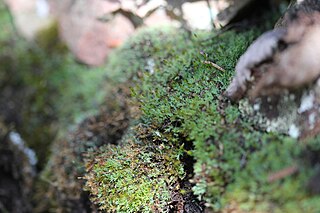
Saelania is a genus of mosses in the monotypic family Saelaniaceae in subclass Dicranidae. The genus was previously placed in family Ditrichaceae. Saelania is named after Finnish botanist Thiodolf Saelan.

Wijkia extenuata, commonly known as spear moss or spiky wiki, is a species of moss from the family Pylaisiadelphaceae. It can be divided into two varieties Wijkia extenuata var. caudata and Wijkia extenuata var. extenuata. It is commonly found throughout the tropical, subtropical, and temperate forests of eastern Australasia and New Zealand.

Pilotrichaceae is a family of pleurocarpous mosses in Hookeriales. It includes 20 genera. It is primarily tropical and epiphytic or epiphyllous.
Cladoradula is a genus of liverworts in the family Radulaceae. Distinguished by its thick, brown-pigmented stems and distinctive branching pattern, it comprises seven species found primarily in tropical and temperate forest regions worldwide. Originally established as a subgenus of Radula in 1885, it was elevated to genus rank in 2022 following molecular studies that revealed it represents one of the oldest lineages within Radulaceae, having diverged during the late Permian period about 263 million years ago. The genus is characterised by its specialised stem structure, distinctive leaf arrangement, and small protective structures around its reproductive organs. Species in the genus grow as epiphytes on tree bark or shaded rocks from sea level to over 2,000 m (6,600 ft) in elevation.

















